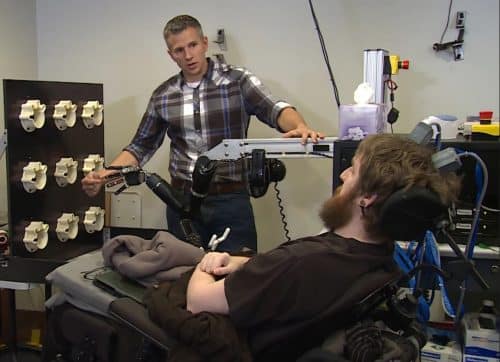"The most important result of this study is that microstimulation of the motor cortex can cause a natural sensation, instead of tingling," said one of the researchers involved in the study

[Translation by Dr. Nachmani Moshe]
Imagine you were involved in a car accident that left you paralyzed in your hands and fingers. Now, imagine that you get back the ability to feel them, a decade later, with the help of a robotic hand controlled by the brain and connected directly to it.
This is exactly what 28-year-old Nathan Copeland experienced after he came out of brain surgery where he was connected to a brain-computer interface, an interface developed by researchers from the University of Pittsburgh and its medical center. In the study, the results of which were published in the scientific journal Science Translational Medicine, a team of researchers led by Robert Gaunt, professor of physical medicine and rehabilitation, demonstrated for the first time ever in humans a technology that allows paralyzed people to regain the sensation of touch with the help of a brain-controlled robotic arm.
"The most important result of this study is that microstimulation of the motor cortex can cause a natural sensation, instead of tingling," said one of the research partners. The stimulation is completely safe, and the reawakened sensations last for months. Further research is still needed in order to better understand the stimulation patterns required to help patients improve their movements."
This is not this research team's first attempt at brain-computer interface technology. About four years ago, Professor Jennifer Collinger, co-author of the paper describing the current study, demonstrated how the technology helped Mrs. Jan Scheuermann, who was paralyzed in all four limbs as a result of a degenerative disease. The video in which the lady is seen eating a chocolate cube by herself with the help of the robotic arm controlled by the brain has been distributed and published all over the world.
However, the way our arms naturally move and react with the environment around us is not controlled only by thinking and moving the appropriate muscles. The person is able to distinguish between a piece of cake and a can of drink with the help of the sense of touch and hold the cake more gently than the can. The constant feedback we receive from the sense of touch is of fundamental importance to the brain that controls movement and grip strength.
For the research team, this step was the obvious next step for their technology. While searching for their suitable candidate, the researchers improved and tuned their system in such a way that the signals received from the robotic arm are transmitted through an array of microelectrodes implanted in the area of the brain where the neurons that control the movement and touch of the hands are located. The microelectrode array and its control system, developed by Blackrock Microsystems, along with the robotic arm, built by Johns Hopkins University's Applied Physics Laboratory, make up all the pieces of the attachment.
Nathan Copeland became paralyzed in all four of his limbs following a car accident. Immediately after the accident, he was registered in the database of candidates willing to participate in a project of clinical trials at the University of Pittsburgh. Almost a decade later, the research team asked him if he was willing to participate in the experimental study. After he passed the initial screening tests, he was moved to the operating room last spring. The researchers implanted arrays of electrodes, each the size of a shirt button, into Natan's brain. Before the surgery itself, imaging methods were used to identify the exact areas in his brain that control the sensations of each of his fingers and palm. "I can literally feel every one of my fingers - it's a really strange feeling," Natan said about a month after the successful surgery he underwent. "Sometimes it feels like an electric current and sometimes like pressure, but in most cases I can tell exactly what each of my fingers is doing. The feeling is as if my fingers are coming into contact with another bone or as if they are being pressed." At the moment, Nathan is able to feel pressure applied to his fingers and the intensity of this pressure to a certain degree, although he cannot tell if the material is hot or cold, explains one of the researchers on the team.
One of the researchers explains the progress in this technology: "Slowly but surely we advanced this research. Four years ago we demonstrated how traffic can be controlled. Now we have shown how the robotic arm can be used to renew the sense of touch of the paralyzed limb." The researcher explains that the whole study is designed to make use of the natural and existing abilities of the brain in order to return to people what was lost but not forgotten. "The ultimate goal is to create a system that allows movement and sensing like a natural arm," explains the lead researcher. "We still have a long way to go to achieve this goal, but the beginning is particularly promising."
